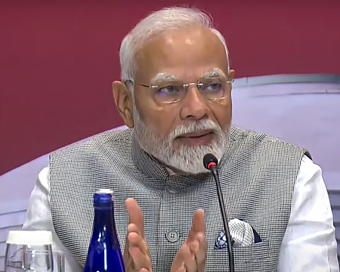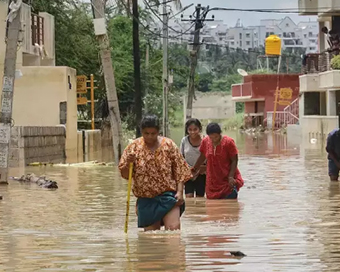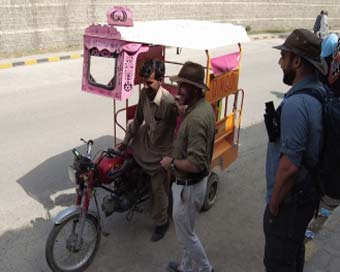 PM Modi visit USA
PM Modi visit USA Only the mirror in my washroom and phone gallery see the crazy me : Sara Khan
Only the mirror in my washroom and phone gallery see the crazy me : Sara Khan Karnataka rain fury: Photos of flooded streets, uprooted trees
Karnataka rain fury: Photos of flooded streets, uprooted trees Cannes 2022: Deepika Padukone stuns at the French Riviera in Sabyasachi outfit
Cannes 2022: Deepika Padukone stuns at the French Riviera in Sabyasachi outfit Ranbir Kapoor And Alia Bhatt's Wedding Pics - Sealed With A Kiss
Ranbir Kapoor And Alia Bhatt's Wedding Pics - Sealed With A Kiss Oscars 2022: Every Academy Award Winner
Oscars 2022: Every Academy Award Winner Shane Warne (1969-2022): Australian cricket legend's life in pictures
Shane Warne (1969-2022): Australian cricket legend's life in pictures Photos: What Russia's invasion of Ukraine looks like on the ground
Photos: What Russia's invasion of Ukraine looks like on the ground Lata Mangeshkar (1929-2022): A pictorial tribute to the 'Nightingale of India'
Lata Mangeshkar (1929-2022): A pictorial tribute to the 'Nightingale of India' PM Modi unveils 216-feet tall Statue of Equality in Hyderabad (PHOTOS)
PM Modi unveils 216-feet tall Statue of Equality in Hyderabad (PHOTOS)The Badminton Association of India (BAI) has announced a 14-member-strong India squad for
- Men’s Sr Hockey Nationals to be played in division-based format from April 4
- Mensik denies Djokovic 100th title in Miami final
- KIPG: Son of a vegetable vendor, Bihar’s Jhandu Kumar eyes Worlds, 2028 Paralympics
- Hardik Singh credits hard work and team unity for receiving HI Midfielder of the Year award
- Djokovic, Alcaraz land in same half of Miami draw
Climate progress in India brightens hopes for Bonn Last Updated : 16 Nov 2017 03:06:59 PM IST 
File Photo: The historic Paris agreement on climate change
Just a few years ago, India relied almost exclusively on coal to fuel its rapid development, opening new coal-burning power plants and increasing coal mining and imports. This year, however, in a remarkable turnaround, India cancelled plans for an additional 14 gigawatts of coal power and announced that it won't build any new coal plants for at least a decade -- thanks to a rapid rise in renewable energy.
As world leaders gather in Bonn for the follow-up to the landmark Paris Climate Agreement, India is one of several standouts in the global emissions picture. This nation of 1.3 billion people, the third-largest emitter of climate pollution, is on track to meet and exceed its Paris commitments. But the challenges India faces as it seeks to lift hundreds of millions out of poverty while tackling climate change are immense. The world needs to be invested in India's climate progress.
The need to scale up climate solutions in India is clear. In New Delhi, citizens are suffering through a week-long toxic smog that has closed schools, cancelled trains and suspended flights. Air pollution, much of it from dirty energy used in vehicles and coal-fired power plants, was linked to the deaths of 1.6 million people last year. Heat waves in India are becoming more severe and deadly as global temperatures rise, killing thousands. And climate change is boosting the intensity of seasonal monsoon rains. Last year 1,200 people across South Asia died in massive flooding, including 500 in the Indian state of Bihar.
Clean energy holds tremendous promise to meet India's complex challenges, and solar development in particular is surging forward. In just a few years, India installed nearly as much solar capacity as the three top US states -- California, New Jersey and Massachusetts -- combined. India is now home to the world's largest solar park, with a bigger one in the works. In Paris, India committed to 40 percent non-fossil energy by 2030, and will likely hit this target by 2022 -- eight years ahead of schedule.
Even on a more individual scale, solar energy is making a huge difference in people's lives. I have seen how solar energy has empowered rural women in the salt flats of Gujarat. Through the partnership with NRDC (Natural Resources Defence Council), SEWA (Self-Employed Women's Association) now has a loan programme that replaces fuel-hungry, inefficient diesel pumps with solar-powered water pumps to use in the salt flats.
Several women I met in this community say they can now save money to pay for their children's education instead of having to put their profits back into diesel fuel. For these families, solar energy is a ticket out of poverty.
In addition to developing a cleaner energy supply, India is working to reduce energy demand from appliances and buildings. The government just launched a new energy-efficient buildings programme that will support investment in about 10 million LED lights, 1.5 million energy-efficient ceiling fans, and 150,000 energy-efficient air conditioners. A new Energy Conservation Building Code, which NRDC is working to implement with partners, has been adopted by eight states, with 15 more to follow. This widespread adoption would make 90 percent of India's infrastructure development more energy efficient.
Financing for clean energy, however, remains a major challenge. Solar prices are dropping rapidly, but researchers estimate that India would need $834 billion in financing to achieve all its Paris targets -- a hefty sum for any nation, let alone a developing country that has not historically contributed to climate pollution.
Leveraging India's limited government funds to bring in more private and international investment will be the key and NRDC is working with experts in India to unlock more investment in clean energy. Green bonds dedicated to clean energy could be one way to attract private capital.
Greenko Energy Holdings, one of India's leading clean energy companies, successfully raised $1 billion with green bonds in July. At the same time, greater financing is needed to scale solutions that bring reliable electricity to underserved communities, such as rooftop solar, microgrids and mini-grids to provide more localised power.
India has made solid progress on its Paris climate commitments. But developing its economy while combating climate change, air pollution and extreme poverty is an enormous undertaking. No nation can make this uphill climb alone. In today's world, countries, cities, states and regions need to work together across borders to support climate solutions and protect people worldwide from the worst impacts of climate change.
Only by accelerating climate action worldwide will we close the emissions gap and achieve the promise of Paris -- a safer climate future for us all.
(Frances Beinecke,IANS For Latest Updates Please-
Join us on
Follow us on








172.31.16.186







